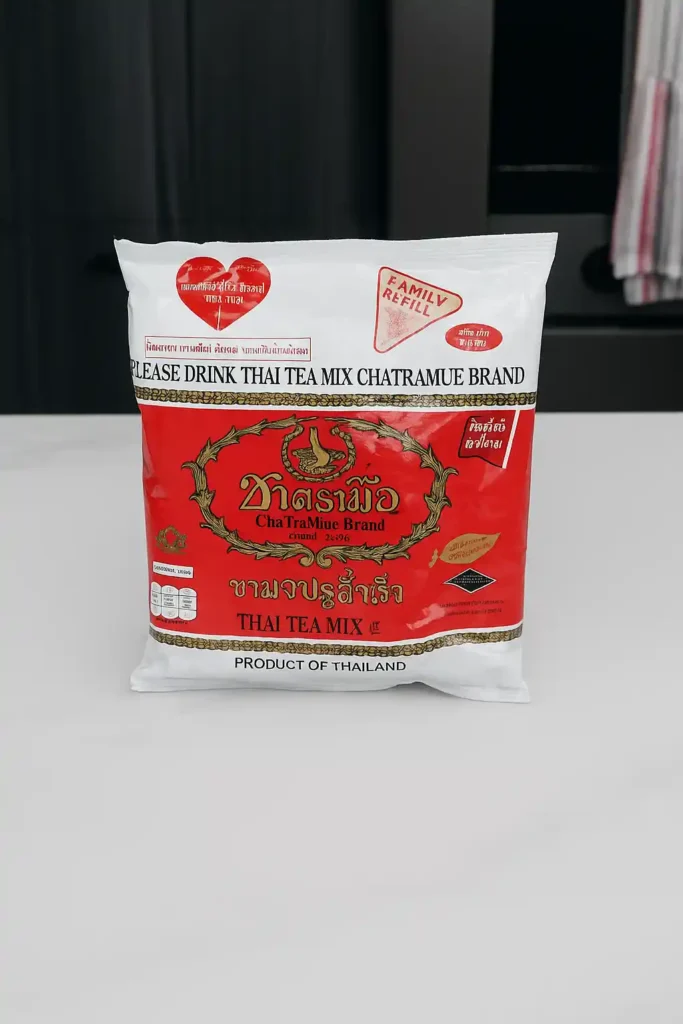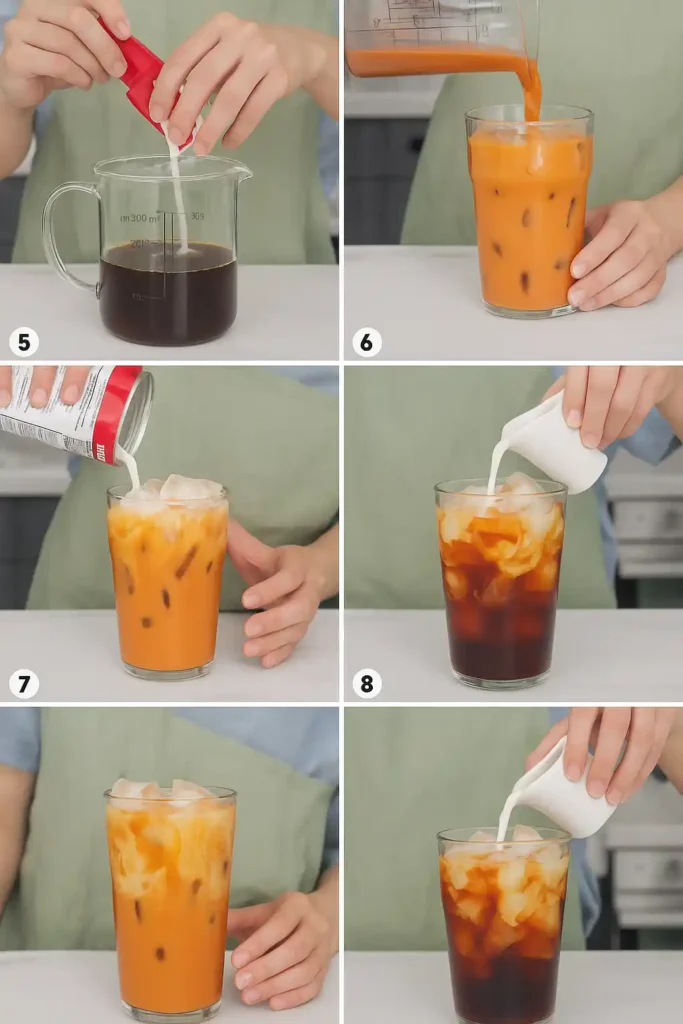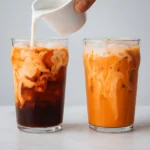Thai tea tea has always been more than a drink for me it’s a memory steeped in orange swirls, sweet spices, and quiet afternoons in my grandmother’s Bangkok kitchen. My name is Elle, and I remember the first time I tasted Thai tea tea like it was yesterday. I was nine, barefoot on the tiled floor, swinging my legs under the wooden table as the scent of star anise and sweet milk filled the air. My grandmother would always brew it fresh strong black tea leaves, steeped deep until their color turned into a copper fire, then mellowed with sweetened condensed milk and poured over crushed ice. That was our ritual.
Years passed, but the craving for Thai tea tea followed me across countries and stages of life. After moving to the U.S., I searched every corner of every Asian grocery store for the exact blend she used. Nothing tasted quite right until I decided to recreate it myself from memory. I wanted more than just a close-enough version; I wanted the exact balance of creamy and spicy that once made me feel at home.
What started as a nostalgic experiment turned into an obsession. I learned what gives Thai tea tea its vibrant orange color (spoiler: it’s not just the tea), why it’s so rich in flavor, and how to make it less sugary without losing the magic. I tested different brewing techniques to keep it from tasting bitter and discovered healthy variations that still feel indulgent. The more I made it, the more I understood how complex and misunderstood this bold drink can be.
In this guide, I’m sharing everything what Thai tea tea is really made of, how it affects your body, why it can sometimes upset your stomach or stain your teeth, and how to make it authentically at home. Whether you’ve only tried it in bubble tea form or you’re trying to replicate that exact iced glass from your favorite Thai restaurant, you’ll find answers here.
Thai tea tea isn’t just a drink. It’s tradition, comfort, and curiosity in one cold, sweet, orange glass. Let me show you why.
What is Thai Tea Tea?
PrintThai Tea Tea: Why Everyone’s Obsessed With This Bold, Creamy Drink
Two easy ways to make the iconic Thai drink at home. You can make it Thai style to try it the way it’s done in Thailand, or make the American style to replicate the tea from your local Thai restaurant.
- Prep Time: 5minutes
- Cook Time: 10minutes
- Total Time: 15minutes
- Yield: 4 serving 1x
- Category: drink
- Cuisine: Thai
Ingredients
Thai Tea Base:
- ¾ cup Thai tea leaves (buy Thai tea leaves online), see note 1
- 4 cups hot off-the-boil water
- ¼ cup sugar
- ⅛ teaspoon salt
Thai Iced Tea – Thai Style (for 1 glass):
- ¾ cup Thai tea base, from above
- 1½ Tablespoons sweetened condensed milk, or to taste
- A pint glass packed full of ice
- 2–3 Tablespoons evaporated milk
Thai Iced Tea – American Style (for 1 glass):
- ¾ cup Thai tea base
- 1 Tablespoon sugar, see note 2
- a pint glass packed full of ice
- 3–4 Tablespoons half and half, (~12% cream)
Instructions
For the Thai Tea Base (4 glass):
- Pour freshly boiled water over the Thai tea leaves and let them steep for 5 minutes. Strain the mixture using a fine mesh sieve or use a French press to simplify the process.
Ingredients: ¾ cup Thai tea leaves, 4 cups just-boiled water - Next, mix in the sugar and salt while the tea is still warm, stirring until fully dissolved. Let the mixture cool completely to avoid melting your ice later. Store the cooled tea concentrate in the fridge it will stay fresh for up to two weeks.
Ingredients: ¼ cup sugar, ⅛ teaspoon salt
For the Thai Style Thai Tea (1 glass):
- In a mixing glass, combine the Thai tea base with sweetened condensed milk, stirring until fully blended. If the tea base is cold from the fridge, briefly warm it in the microwave to help the condensed milk mix in smoothly.
Ingredients: ¾ cup Thai tea base, 1½ tablespoons sweetened condensed milk. - Fill a tall glass to the brim with ice cubes. Pour the tea mixture over the ice, then finish with a generous drizzle of evaporated milk for that classic layered look. Sip and enjoy!
Ingredients: Ice (fill a pint glass), 2–3 tablespoons evaporated milk.
For the American Style Thai Tea (1 glass):
- In a mixing glass, combine the Thai tea base with sugar, adjusting the sweetness to your liking. If the tea is cold, warming it slightly in the microwave will help the sugar dissolve more easily.
Ingredients: ¾ cup Thai tea base, 1 tablespoon sugar. - Fill a tall glass to the top with ice. Pour the sweetened tea over the ice, then finish it off with a creamy pour of half-and-half. Stir if desired, and enjoy chilled!
Ingredients: Ice (fill a pint glass), 3–4 tablespoons half-and-half.
Notes
- If Thai tea leaves aren’t available to you, don’t worry I’ve shared a creative workaround in the blog post that gives a similar flavor.
- I purposely keep the base lightly sweetened so everyone can fine-tune the sweetness to their liking. But if you’re prepping it for yourself and know your preferred level, go ahead and sweeten the tea base with ½ cup of sugar (or more), and skip adding extra sugar when assembling each glass.
Nutrition
- Serving Size: 4 glass (16 oz)
- Calories: ~250 kcal
- Sugar: ~28 g
- Sodium: ~85 mg
- Fat: ~6 g
- Saturated Fat: ~4 g
- Unsaturated Fat: ~2 g
- Trans Fat: 0 g
- Carbohydrates: ~40 g
- Fiber: 0 g
- Protein: ~4 g
- Cholesterol: ~20 mg
What Makes Thai Tea Unique Compared to Regular Tea?

Thai tea tea stands out the moment it hits your glass. Unlike regular black tea, this vibrant, milky-orange drink delivers a rich fusion of flavors. It’s sweet, spicy, creamy and unmistakably bold. What makes it different isn’t just the base tea (usually a strong black tea like Ceylon), but the layers added to it: sugar, condensed milk, sometimes star anise or cardamom, and a pinch of food coloring that gives it its signature look.
Regular tea might give you a morning jolt, but thai tea tea is an experience. It’s thicker, silkier, and far more indulgent. Plus, it’s often served iced, which gives it a completely different mouthfeel compared to typical hot teas.
Brief History and Cultural Origin of Thai Tea Tea
The story of thai tea tea starts in Thailand’s bustling post-war markets. As Western influence grew, local vendors began using black tea imported from China or Sri Lanka. They sweetened it with sugar and canned condensed milk two ingredients widely available at the time and poured it over ice to beat the tropical heat.
It quickly became a favorite at street stalls, served in tall glasses or plastic bags with straws. Over time, the drink evolved with added spices and food coloring, turning it into the bright, aromatic beverage we know today. Now, thai tea tea isn’t just a drink it’s a symbol of Thai street culture and global fusion.
Thai Tea Tea Ingredients Breakdown
Core Components: What Is Thai Tea Made Of?
The heart of any thai tea tea recipe is strong brewed black tea. But that’s just the beginning. Classic recipes often include:

Thai Tea Base:
- ¾ cup Thai tea leaves (buy Thai tea leaves online), see note 1
- 4 cups hot off-the-boil water
- ¼ cup sugar
- ⅛ teaspoon salt
Thai Iced Tea – Thai Style (for 1 glass):
- ¾ cup Thai tea base, from above
- 1½ Tablespoons sweetened condensed milk, or to taste
- A pint glass packed full of ice
- 2-3 Tablespoons evaporated milk
Thai Iced Tea – American Style (for 1 glass):
- ¾ cup Thai tea base
- 1 Tablespoon sugar, see note 2
- a pint glass packed full of ice
- 3-4 Tablespoons half and half, (~12% cream)
Each of these ingredients plays a role. The tea provides a robust base, while the milk and sugar add body and sweetness. Some vendors spice things up with aromatic blends, giving the drink an exotic twist. All together, these elements build the flavor profile thai tea tea is famous for.
What Makes Thai Tea So Orange?
Let’s face it thai tea tea is instantly recognizable because of its glowing orange hue. But what causes that? It’s not a natural pigment from tea leaves. Traditional Thai vendors often add yellow or red food coloring to enhance the look of the drink.
The food dye reacts with the milk to create that famous creamy orange tone. While some modern blends skip the dye and stick to natural ingredients, most commercial and restaurant-style thai tea tea still includes food coloring for visual appeal.
How to Make Authentic Thai Tea Tea at Home
Step-by-Step Brewing Process (Thai Style)
Brewing thai tea tea at home is easier than it sounds. Here’s a classic step-by-step method:
To Prepare the Thai Tea Base (Yields 4 Glasses):

- Pour freshly boiled water over the Thai tea leaves and let them steep for 5 minutes. Strain the mixture using a fine mesh sieve or use a French press to simplify the process.
Ingredients: ¾ cup Thai tea leaves, 4 cups just-boiled water. - Next, mix in the sugar and salt while the tea is still warm, stirring until fully dissolved. Let the mixture cool completely to avoid melting your ice later. Store the cooled tea concentrate in the fridge it will stay fresh for up to two weeks.
Ingredients: ¼ cup sugar, ⅛ teaspoon salt.
For the Thai Style Thai Tea (1 glass):

- In a mixing glass, combine the Thai tea base with sweetened condensed milk, stirring until fully blended. If the tea base is cold from the fridge, briefly warm it in the microwave to help the condensed milk mix in smoothly.
Ingredients: ¾ cup Thai tea base, 1½ tablespoons sweetened condensed milk - Fill a tall glass to the brim with ice cubes. Pour the tea mixture over the ice, then finish with a generous drizzle of evaporated milk for that classic layered look. Sip and enjoy!
Ingredients: Ice (fill a pint glass), 2–3 tablespoons evaporated milk.
To Make One Glass of American-Style Thai Tea:
- In a mixing glass, combine the Thai tea base with sugar, adjusting the sweetness to your liking. If the tea is cold, warming it slightly in the microwave will help the sugar dissolve more easily.
Ingredients: ¾ cup Thai tea base, 1 tablespoon sugar - Fill a tall glass to the top with ice. Pour the sweetened tea over the ice, then finish it off with a creamy pour of half-and-half. Stir if desired, and enjoy chilled!
Ingredients: Ice (fill a pint glass), 3–4 tablespoons half-and-half
Now you’ve got a perfectly chilled, creamy glass of homemade thai tea tea.
Tips to Avoid Bitterness When Brewing Thai Tea
To avoid bitterness, don’t over-steep the tea. Aim for a steeping time of 3 to 5 minutes max. Also, make sure your water isn’t boiling about 190°F works best. Want a smoother sip? Strain well and stir gently before serving.
Health Insights: Is Thai Tea Tea Good or Bad for You?
Thai Tea Tea and Your Body: Benefits and Downsides
Like many sweet treats, thai tea tea has both pros and cons. On the plus side, the black tea base contains antioxidants like theaflavins, which support heart health and help fight free radicals. Some versions with added spices like cardamom or star anise offer digestive benefits too.
However, the condensed milk and sugar in thai tea tea push the calorie count up. A typical serving can have over 200 calories and that’s before the boba pearls! Drinking it occasionally is fine, but daily consumption could contribute to weight gain or sugar-related issues.
Does Thai Tea Have a Lot of Caffeine?
Yes, thai tea tea does contain a moderate to high amount of caffeine, depending on the strength of the tea base. An average 16 oz glass can contain anywhere from 30 to 60 mg of caffeine. That’s less than coffee but more than herbal tea. So, while it might give you a pick-me-up, it can also affect your sleep if consumed too late.
Potential Side Effects of Thai Tea Tea
Why Does Thai Tea Hurt My Stomach?
Some people report feeling bloated or experiencing stomach cramps after drinking thai tea tea. This is usually due to the dairy content and sugar overload. The combination of black tea’s natural acidity and condensed milk can irritate sensitive stomachs. If you’re lactose intolerant or prone to acid reflux, approach with caution.
Can Thai Tea Tea Stain Your Teeth?
Absolutely. The rich color of thai tea tea especially when mixed with milk can stain tooth enamel over time. Its dark tea base contains tannins, which cling to enamel and cause discoloration. And with added coloring agents, the staining potential only increases. To reduce the risk, use a straw or rinse your mouth after drinking.
Thai Tea Tea vs Other Popular Teas
Thai Tea vs Chai Tea: How Are They Different?
At first glance, thai tea tea and chai might seem similar they’re both spiced, sweet, and creamy. But they come from different worlds. Chai, originating in India, includes a stronger mix of spices like cinnamon, cloves, ginger, and pepper. It’s often brewed with milk from the start.
Thai tea tea, on the other hand, leans toward sweetness with subtle spice. It’s brewed as a strong tea concentrate and mixed with condensed milk after steeping. The flavor is less about heat and more about richness.
Is Matcha or Thai Tea Healthier?
When comparing thai tea tea to matcha, the answer is clear matcha wins on the health front. Matcha is made from whole green tea leaves, loaded with antioxidants, and has no added sugar unless you sweeten it. Thai tea tea, though flavorful, is typically high in sugar and calories. If health is the priority, matcha is the better choice.
What Makes Thai Tea Taste Like Thai Tea?
Flavors, Spices, and Signature Notes of Thai Tea
The flavor of thai tea tea is a balance of bold and creamy. It starts with the earthy strength of black tea, then gets mellowed by sweetened condensed milk. Depending on the brand or recipe, you may also notice notes of vanilla, cardamom, or tamarind. Some blends include food-grade orange blossom water or other natural flavors to deepen the complexity.
That unmistakable taste? It’s the combination of spice, sugar, tea tannins, and milk fat all wrapped up in one chilly sip.
Why Does Thai Tea Taste Bitter Sometimes?
Bitterness in thai tea tea usually comes from over-steeping the tea leaves or using water that’s too hot. Black tea is sensitive, and steeping it too long releases tannins, making the brew overly sharp. If your tea tastes bitter, try reducing the steep time to 3–5 minutes or adding a touch more milk to mellow it out.
Thai Tea Tea and Calories
Why Does Thai Tea Have So Many Calories?
The creamy texture and sweet flavor of thai tea tea don’t come free. A single glass can pack in 200–300 calories. Why? Condensed milk and sugar are both calorie-dense ingredients. Add-ons like boba pearls or flavored syrups only increase the total.
That’s why this drink, while delicious, should be considered more of a dessert than a daily beverage.
Hidden Sugars and Creams in Thai Tea Recipes
Most people don’t realize how much sugar goes into thai tea tea often several tablespoons in a single serving. Many restaurants use pre-made powdered mixes that already contain artificial flavorings, sugars, and creamers. If you’re watching your sugar intake, consider making your own version at home with natural sweeteners and lighter milk options.
Thai Tea Tea Recipe and Serving Ideas
Variations: Thai Iced Tea, Hot Thai Tea, Vegan Thai Tea
There’s more than one way to enjoy thai tea tea:
- Thai Iced Tea: The classic version with condensed milk and ice.
- Hot Thai Tea: Skip the ice and enjoy it warm ideal for chilly evenings.
- Vegan Thai Tea: Use coconut milk or almond milk and sweeten with agave or maple syrup.
Each version keeps the spirit of thai tea tea alive while fitting different dietary needs.
Ingredients Table and Measurement Guide
| Ingredient | Quantity | Notes |
|---|---|---|
| Thai tea mix / black tea | 2 tbsp | Use Ceylon or Assam |
| Water | 2 cups | Filtered for best results |
| Sweetened condensed milk | 2 tbsp | Adjust to taste |
| Evaporated milk | 1 tbsp | Or use regular milk |
| Sugar | 1–2 tsp | Optional |
| Ice | 1 cup | Crushed preferred |
With these exact measurements, you’ll create a delicious and balanced thai tea tea that rivals any café.
FAQs About Thai Tea Tea
What is Thai tea made of?
Thai tea tea is made from strong black tea (usually Ceylon or Assam), sweetened condensed milk, evaporated milk or whole milk, sugar, and optional spices like star anise or cardamom. It’s often colored with food dye to give it that iconic orange hue.
Why does my stomach hurt after drinking Thai tea?
This could be due to the high dairy and sugar content in thai tea tea. If you’re lactose intolerant or sensitive to heavy milk, the condensed milk and added sugars may upset your stomach. Opting for dairy-free versions can help.
What is the difference between Thai tea and regular tea?
Regular tea is usually unsweetened and served hot or plain. Thai tea tea, however, is brewed strong, sweetened with condensed milk, and often served iced. It’s creamier, richer, and spiced for added depth.
What makes Thai tea so orange?
The bright orange color of thai tea tea typically comes from food coloring added to Thai tea blends. When combined with milk, it creates the signature pastel orange hue.
Is Thai tea good or bad for you?
Thai tea tea can be enjoyed in moderation. It provides antioxidants from black tea, but it’s also high in sugar and calories. Homemade versions with less sugar and dairy alternatives are a healthier choice.
Does Thai tea have a lot of caffeine?
Yes, thai tea tea contains moderate caffeine—typically 30–60 mg per serving. It’s less than coffee but more than herbal teas.
Why does Thai tea make my teeth orange?
Because thai tea tea contains tannins and food coloring, it can stain teeth over time, especially with regular consumption. Using a straw and rinsing your mouth after drinking can help reduce staining.
What makes Thai tea taste like Thai tea?
The taste of thai tea tea comes from strong black tea blended with creamy condensed milk and optional spices. The result is a sweet, rich, and lightly spiced flavor that’s hard to forget.
Why does Thai tea have so many calories?
It’s the condensed milk and sugar. A typical glass of thai tea tea can contain 200–300 calories or more, depending on how it’s prepared and what toppings (like boba) are added.
What is the difference between chai tea and Thai tea?
Chai is spicier and brewed with cinnamon, cloves, and ginger. Thai tea tea is milder, sweeter, and creamier, often featuring condensed milk and food coloring for its signature color and taste.
Is matcha or Thai tea healthier?
Matcha is generally healthier. It’s packed with antioxidants and is low in sugar by default. Thai tea tea is richer and sweeter, which means more calories and sugar.
Why does my Thai iced tea taste bitter?
Over-steeping black tea or using water that’s too hot can make thai tea tea bitter. Steep gently for 3–5 minutes and avoid boiling water for smoother results.
Conclusion
Thai tea tea is more than just a colorful drink it’s a story in a glass. From its spicy-sweet aroma to its creamy texture, it captures the essence of Thai street culture and personal tradition. Whether you fell in love with it in a café or through your own kitchen experiments, you now know what makes it special and how to recreate it perfectly at home.
Looking for other soothing drinks with vibrant color and wellness benefits? Check out our butterfly pea tea recipe a calming, caffeine-free option that’s just as beautiful and steeped in tradition.


